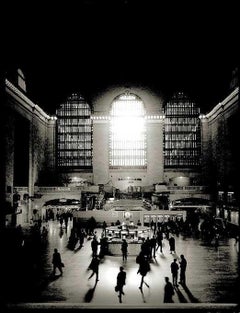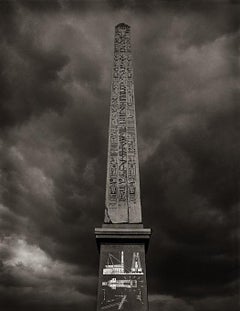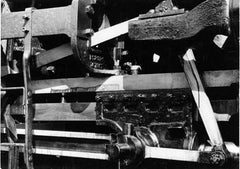20th Century Still-life Photography
to
39
269
138
56
62
34
Overall Width
to
Overall Height
to
7
562
4,692
1
1
10
10
11
24
21
39
148
184
247
65
37
30
26
9
1
1
1
237
206
114
164
101
83
65
49
43
39
33
30
30
29
29
28
28
27
24
24
20
20
19
211
199
180
112
109
44
29
27
23
21
66
73
388
172
Period: 20th Century
Beauty and Beast II model in desert with monkey and giraffe in the back
By Michel Comte
Located in Vienna, AT
Other sizes and high-end frame on request. For decades Michel Comte has been shooting protagonists from the world of art, film and entertainment. However, he does not only take photo...
Category
Contemporary 20th Century Still-life Photography
Materials
Archival Pigment
Eye Chair 1969
Located in Carmel-by-the-Sea, CA
Signed on the front. Contact gallery for prices and available sizes.
Category
20th Century Still-life Photography
Materials
Silver Gelatin
Price Upon Request
Untitled, Garden Study with Rosebuds
By Josef Sudek
Located in Carmel-by-the-Sea, CA
Signed on front of print.
Category
20th Century Still-life Photography
Materials
Silver Gelatin
Price Upon Request
Grand Central Terminal - black and white people walking in the train station
Located in Vienna, AT
Other sizes and high end framing on request. With his latest works, Andreas H. Bitesnich, the master of minutely detailed studio compositions proves that he is just as capable of cap...
Category
Contemporary 20th Century Still-life Photography
Materials
Archival Pigment
Paris the city view in black and white with clouds in the back
Located in Vienna, AT
Other sizes and high end framing on request. With his latest works, Andreas H. Bitesnich, the master of minutely detailed studio compositions proves that he is just as capable of cap...
Category
Contemporary 20th Century Still-life Photography
Materials
Archival Pigment
Locomotive Drive, California
By Brett Weston
Located in Carmel-by-the-Sea, CA
Signed and dated on front of the mount.. Stamped on back of the mount Portfolio Print No. 1 with number in pencil, from Abstractions Portfolio #2. Printed in 1980.
Category
20th Century Still-life Photography
Materials
Silver Gelatin
Price Upon Request
Leaf, Hawaii
By Brett Weston
Located in Carmel-by-the-Sea, CA
Signed and dated on mount recto.
Category
20th Century Still-life Photography
Materials
Silver Gelatin
Price Upon Request
English National Opera #1, London, England - women behind the scences play cards
Located in Vienna, AT
Other sizes and prices on request. Gerard Uferas' photographs have appeared in numerous publications, including "Liberation", "Time Magazine", "The New York Times", "Le Monde", and "...
Category
Contemporary 20th Century Still-life Photography
Materials
Silver Gelatin
Stairway with Broom, New York, NY
By Brett Weston
Located in Carmel-by-the-Sea, CA
Signed and dated on the front of the mount by the artist. Printed in 1980s.
Category
20th Century Still-life Photography
Materials
Silver Gelatin
Price Upon Request
Leaves and Cobwebs, 1969
By Wynn Bullock
Located in Carmel-by-the-Sea, CA
Signed on the front of the mount.
Category
20th Century Still-life Photography
Materials
Silver Gelatin
Price Upon Request
Storks Bill, Storchschnabel
By W. Jentzsch
Located in Carmel-by-the-Sea, CA
Artist stamp, monogrammed 'W.J.', titled in pencil and numbered in red crayon on back of mount.
Category
20th Century Still-life Photography
Materials
Silver Gelatin
Price Upon Request
Wilde Klematis
By W. Jentzsch
Located in Carmel-by-the-Sea, CA
Artist stamp, monogrammed 'W.J.', titled in pencil and numbered in red crayon on mount verso.
Category
20th Century Still-life Photography
Materials
Silver Gelatin
Price Upon Request
Toadstool, 1931, 4FU
Located in Carmel-by-the-Sea, CA
Unsigned - fine print used for reproduction. From the Estate of Cole Weston.
Category
20th Century Still-life Photography
Materials
Silver Gelatin
Price Upon Request
Ski Adaptation for Finnesko
Located in London, GB
Stamped with Scott Polar Research Institute blind stamp and numbered 1/30 on reverse
Platinum print
Available in two sizes:
20 x 14 inches, edition of 30
31 1/2 x 23 inches, edition...
Category
20th Century Still-life Photography
Materials
Platinum
Price Upon Request
Sledging Rations for 1 Man for 1 Day
Located in London, GB
Stamped with Scott Polar Research Institute blind stamp and numbered 2/30 on reverse
Platinum print
Available in two sizes:
20 x 14 inches, edition of 30
31 1/2 x 23 inches, edition...
Category
20th Century Still-life Photography
Materials
Platinum
Price Upon Request
Palm Canyon, Borrego Desert, 1937
Located in Carmel-by-the-Sea, CA
Initialed and dated front of mount. Negative number annotated on back of mount. Negative Code B-PC-9G. Printed in 1938.
Category
20th Century Still-life Photography
Materials
Silver Gelatin
Price Upon Request
Horse Head Skull
By Morley Baer
Located in Carmel-by-the-Sea, CA
Signed by the artist.
Category
20th Century Still-life Photography
Materials
Silver Gelatin
Price Upon Request
Cactus
By Wynn Bullock
Located in Carmel-by-the-Sea, CA
Signed on the front of the mount by the artist.
Category
20th Century Still-life Photography
Materials
Silver Gelatin
Price Upon Request
"World Cup", 1999
By Steve Miller
Located in Hudson, NY
In this specific use of X-ray, Miller creates a collage-like composition that renders 3-D objects into 2-D space. The soccer ball floats as light as an orb or bubble, suspended among...
Category
Contemporary 20th Century Still-life Photography
Materials
Archival Paper
Price Upon Request
"Clarinet", 1997
By Steve Miller
Located in Hudson, NY
While all photography arrests motion, it is only the X-ray that allows us to climb inside a particular moment and subject and parse the structure of its beauty from within. Miller’s ...
Category
Contemporary 20th Century Still-life Photography
Materials
Archival Paper
Price Upon Request
"Tulips", 1995
By Steve Miller
Located in Hudson, NY
A lovely bundle of tulips takes on a skeletal quality in this X-ray photograph by Steve Miller. The delicate, transparent petals of the tulip flowers are contrasted by the wiry const...
Category
Contemporary 20th Century Still-life Photography
Materials
Archival Paper
Price Upon Request
"Sunflower", 1995
By Steve Miller
Located in Hudson, NY
While all photography arrests motion, it is only the X-ray that allows us to climb inside a particular moment and subject and parse the structure of its beauty from within.
Miller’...
Category
Contemporary 20th Century Still-life Photography
Materials
Archival Paper
Price Upon Request
Recently Viewed
View AllMore Ways To Browse
Used Serena And Lily
Van Gindertael
Vaux Le Vicomte
Velos Antique
Verbrugghe Charles
Victor Higgins
Vintage Amateur Radio
Vintage Ballerina Mirror
Vintage Celtics Poster
Vintage Fetish Heels
Vintage Hawaii Souvenir
Vintage Velvet Painting Mexico
Virgen De Guadalupe
Virgen Del Carmen
Virginia Shackles
Visser T Hooft
Volney Richardson
W R Jennings





